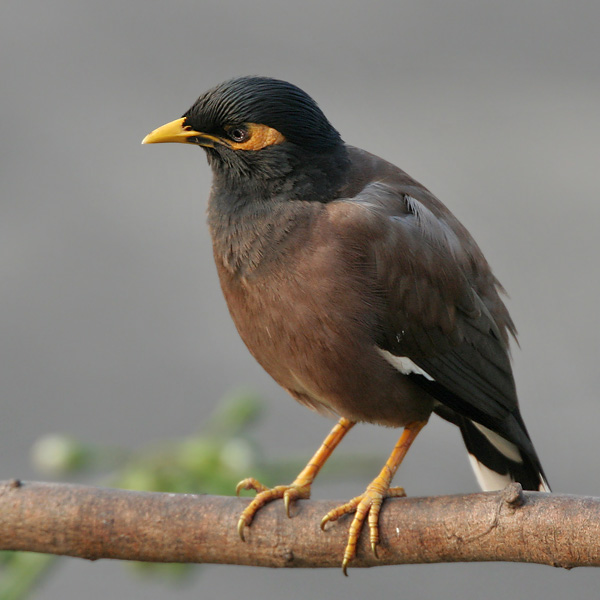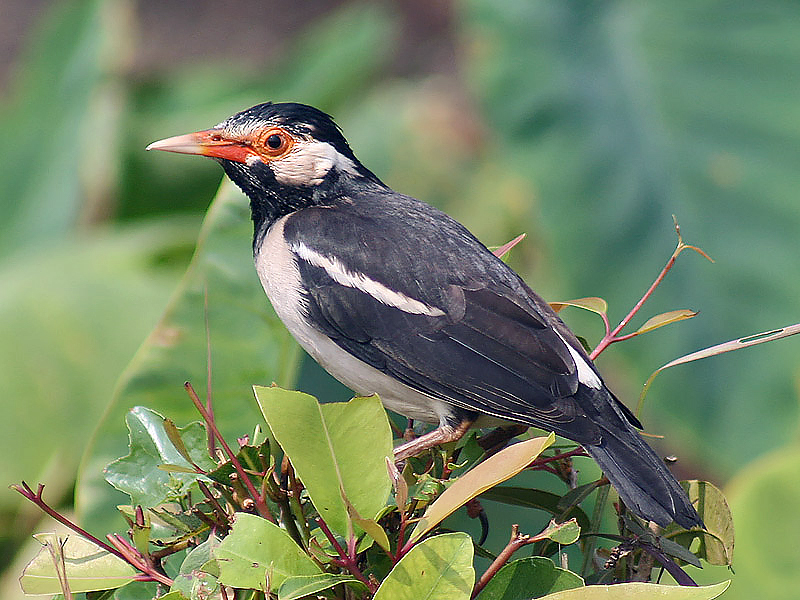Birdwatching is a delight, waking up early enough to do so isn't. On the rare occasion I will summon my senses to take to to the National Park for a BNHS outing. So it comes as a surprise to me that I have been waking up early every morning to go looking for birds.
Two reasons. One is Raga Pitradhwani, the daily nudging by my father to wake earlier in the healthy, wealthy and wise tradition.
The other is Raga Begada, which the hordes of sparrows in our garden begin at 5 AM. Once they have started, unless they finish their evening thillana, there is no more sleeping.
And this morning, I hit a jackpot. I've never seen as much colour, heard as much song as I did today. All I did was walk twice around our housing society compound.

Of course, there were firstly, the huge hordes of house sparrows (Passer domesticus indicus). Hordes, because you have to visit my place to see them. It is as if every sparrow in Mumbai has chosen to come and live here. The population of sparrows is declining in many places, but not in our garden.

And that's because our three buildings are full of little holes in the window-ledges (that's how the builder made them) where they can shelter from cats, crows, kites, rats and other nuisances. Which means they breed like, uh, well, sparrows.
A wish is to see the rare yellow-throated sparrow, the bird that changed sálim Ali from a hunter to a conservationist. But my skills aren't that great, all I do is write 'little brown bird' when I sight one of several species whhich look the same.
The bird that is rare in our garden is that splendid bird - the house crow (Corvus splendens). A bird much celebrated in literature and art, from the Panchatantra to Ruskin Bond, and painted in whole murders by R.K. Laxman, it doesn't seem to get enough to eat, except in the rubbish dump at the end of the garden.

Probably got to do with the fact that the society is made up of tony people who think making an offering to crows before a meal is just an old Hindu practice. Maybe also because the grills they place on their windows deter crows. And perhaps the little garbage that is there in the dump, is cornered by the dogs.
And perhaps because they has to share space with their shy cousins, the Jungle Crows (Corvus macrorhynchos culminatus).

Once you come to know them, you feel so sorry for them. They have a harsher call, don't appear as smart as their urban cousins, and generally keep to themselves. In our society, they occupy the end of the garden, away from human presence. And personally, I think they are very cute.
Our society has any number of feral blue rock pigeons (Columba livia intermedia). I hate them - 'flying rats' is an apt description.

In cities, they have originated from domesticated pigeons gone wild again, and because they have any number of ledges and flat surfaces to breed on, they have outcompeted sparrows.
And then we have the clever little bird, the Indian myna (Acridotheres tristis tristis).

The range of calls they have is fabulous, especially the pair that nests outside our window.
The great joy was to see a pair of Pied mynas(Gracupica contra), on the dead tree (on the road leading intto the society) this morning.

Though it's a relatively common bird, I am never fortunate to see it often. To see a pair was indeed a visual lottery.
Crowning glory of the day - to see a courting pair of magpie-robins (Copsychus saularis saularis) flying up and down and all over the garden.

The black-and-white plumage contrasts beautifully with the green-red-white of our garden.
Two unidentified black birds also I saw, slightly smaller than the magpie-robins. later Sálim Ali told me that one of them was most likely was a pied bush chat (Saxicola caprata probably nilgiriensis or bicolor).

If it holds true (which will remain a hope till I get an ornithologist to verify another sighting), I will have added another species to what I know, and be really glad of that.
A drongo (Dicrurus macrocercus macrocercus) occupies our huge Bougainvillea tree, and I saw him in his perennial battle with our local pariah kite (Milvus migrans govinda).


Birds I missed were the rose-ringed parakeet, the munia and the crow-pheasant. Now they haunt me, and I have to roam the garden every morning hoping for a sighting. I heard the koel, and wish I didn't - I find this parasitic bird very repulsive, but that is a personal bias.
To imagine I saw all of this in one morning, and I have lived here for seven years!
Two reasons. One is Raga Pitradhwani, the daily nudging by my father to wake earlier in the healthy, wealthy and wise tradition.
The other is Raga Begada, which the hordes of sparrows in our garden begin at 5 AM. Once they have started, unless they finish their evening thillana, there is no more sleeping.
And this morning, I hit a jackpot. I've never seen as much colour, heard as much song as I did today. All I did was walk twice around our housing society compound.

Of course, there were firstly, the huge hordes of house sparrows (Passer domesticus indicus). Hordes, because you have to visit my place to see them. It is as if every sparrow in Mumbai has chosen to come and live here. The population of sparrows is declining in many places, but not in our garden.

And that's because our three buildings are full of little holes in the window-ledges (that's how the builder made them) where they can shelter from cats, crows, kites, rats and other nuisances. Which means they breed like, uh, well, sparrows.
A wish is to see the rare yellow-throated sparrow, the bird that changed sálim Ali from a hunter to a conservationist. But my skills aren't that great, all I do is write 'little brown bird' when I sight one of several species whhich look the same.
The bird that is rare in our garden is that splendid bird - the house crow (Corvus splendens). A bird much celebrated in literature and art, from the Panchatantra to Ruskin Bond, and painted in whole murders by R.K. Laxman, it doesn't seem to get enough to eat, except in the rubbish dump at the end of the garden.

Probably got to do with the fact that the society is made up of tony people who think making an offering to crows before a meal is just an old Hindu practice. Maybe also because the grills they place on their windows deter crows. And perhaps the little garbage that is there in the dump, is cornered by the dogs.
And perhaps because they has to share space with their shy cousins, the Jungle Crows (Corvus macrorhynchos culminatus).

Once you come to know them, you feel so sorry for them. They have a harsher call, don't appear as smart as their urban cousins, and generally keep to themselves. In our society, they occupy the end of the garden, away from human presence. And personally, I think they are very cute.
Our society has any number of feral blue rock pigeons (Columba livia intermedia). I hate them - 'flying rats' is an apt description.

In cities, they have originated from domesticated pigeons gone wild again, and because they have any number of ledges and flat surfaces to breed on, they have outcompeted sparrows.
And then we have the clever little bird, the Indian myna (Acridotheres tristis tristis).

The range of calls they have is fabulous, especially the pair that nests outside our window.
The great joy was to see a pair of Pied mynas(Gracupica contra), on the dead tree (on the road leading intto the society) this morning.

Though it's a relatively common bird, I am never fortunate to see it often. To see a pair was indeed a visual lottery.
Crowning glory of the day - to see a courting pair of magpie-robins (Copsychus saularis saularis) flying up and down and all over the garden.

The black-and-white plumage contrasts beautifully with the green-red-white of our garden.
Two unidentified black birds also I saw, slightly smaller than the magpie-robins. later Sálim Ali told me that one of them was most likely was a pied bush chat (Saxicola caprata probably nilgiriensis or bicolor).

If it holds true (which will remain a hope till I get an ornithologist to verify another sighting), I will have added another species to what I know, and be really glad of that.
A drongo (Dicrurus macrocercus macrocercus) occupies our huge Bougainvillea tree, and I saw him in his perennial battle with our local pariah kite (Milvus migrans govinda).


Birds I missed were the rose-ringed parakeet, the munia and the crow-pheasant. Now they haunt me, and I have to roam the garden every morning hoping for a sighting. I heard the koel, and wish I didn't - I find this parasitic bird very repulsive, but that is a personal bias.
To imagine I saw all of this in one morning, and I have lived here for seven years!
Comments